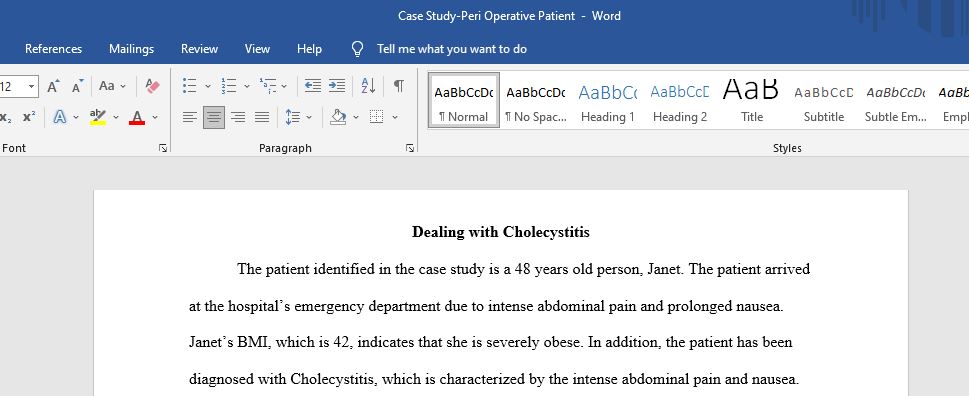Case Study-Dealing with Cholecystitis
Context
Acute surgical admissions are a common practice for most hospitals and therefore, nurses. The
ability of a Registered Nurse to understand the pathophysiology and manifestations of more
common illnesses allows for greater advocacy for patients; and enables the nurse to better evaluate
the interventions in place.
Completion of this assessment will test your knowledge relating to the pathophysiology, clinical
manifestations, investigations and treatments of a common acute surgical admission. The
assessment will further determine your ability to interpret and apply this knowledge to the holistic
nursing care of a patient with this illness.
Instructions
To complete this assessment, you will need to read and understand the case study presented below
and provide detailed responses to each of the points listed. Your detailed responses should be
presented in the format of a report, summarising the scenario and its implications. For each point,
you should have a separate heading.
The points to address in your report, are as follows:
1. Summarise the situation and patient identified in the case study.
2. Identify and describe the illness and relevant pathophysiology of the illness indicated.
3. Identify the common clinical manifestations (signs and symptoms) for the illness you
described.
4. Consider and discuss the legal and ethical implications of consent giving whilst under the
influence of intravenous narcotics.
o You must decide whether the patient is fit to consent, and if not, who may be able to
consent for her. You should discuss potential confidentiality and privacy issues in
relation to her location for admission.
5. Identify the potential issues that could be faced when undergoing surgery in this case study,
related to pain, digestion and oxygenation and formulate an intervention plan that explains
how to manage each one.
o Note: This plan should be a paragraph on each aforementioned issue, which includes
the considerations for each intervention and the clinical reasoning behind them.
CAP203_Assessment_3_Brief_Module 4.1 Page 2 of 5
Writing your response
You should start with a short introduction (approximately 200 words) detailing the case study and
the identified acute illness. This section should be written in complete sentences and paragraphs,
using appropriate language and punctuation. This section should not be dot points, lists, graphs or
diagrams.
The main body of your case study should be approximately 1000 words long, with separate sections
dedicated to each aspect of the instructions (points 2-6 inclusive). This section must be written in full
sentences and paragraphs; using appropriate language and punctuation. The report should be
written in the third person. The use of tables, graphs and dot points is not required. All arguments
and information presented should be appropriately referenced as per the APA referencing guide.
The report should end with a conclusion, which should be approximately 300 words in length, and
summarise the case study and information presented. This section should not include new
information. You may identify potential areas for further study and or/research in this section; this
should be rationalised to include impact on future admission and patient outcomes. The inclusion of
potential areas for further research is not a mandatory component of this assessment.

